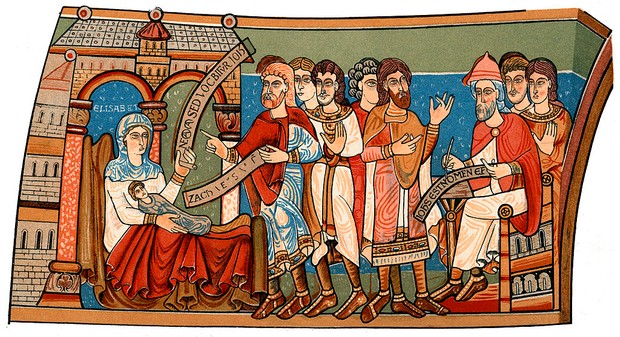Sometimes it can feel like the internet has been around forever. Particularly for Zoomers, it can be weird even imagining what the world was like before you could address a worldwide audience with a Tweet or a TikTok. Older readers will remember calling friends up on a landline to arrange a time and place to meet in person.
But imagine a world where you had none of these options. No IMs, no email, no phones. In the 18th and 19th centuries, the only source of news would be periodicals which were sporadically available, and almost always very much out of date by the time they reached places far away from their source. The only means of long-distance communication then was letter-writing.
But go back even further. In the Medieval era (c. 500 CE – c. 1500 CE), there was very little in terms of formal education, so most people couldn’t read or write. The printing press was only invented at the very end of the Medieval period, and so even the very few written sources that existed all had to be made laboriously by hand. What was the equivalent of social media in the Middle Ages? How did people get their news and keep in touch?

A Pint at the Tavern
Probably one of the most obvious cliches of Medieval life is the tavern. In the early Medieval period, taverns would have been little more than a front room of the brewer’s house, where people would gather of an evening to talk and drink. This was a very important venue and an esteemed social role, because water was often contaminated and dangerous to drink, with most hydration being taken in the form of weakly alcoholic ale, the brewing of which kills dangerous microbes – which is where we get the phrase ‘small beer’. In Saxon England (c. 600 – 1066 CE), brewing ale was a job done primarily by women, and the alewife would put a green bush on a pole outside the brewery to indicate a fresh batch was ready to drink. This tradition evolved into the ‘pub sign’, and spawned names such as the ‘Holly Bush’. As the Medieval period evolved, they became a specific type of establishment, where a taverner would have made a living out of providing beer, food and lodging for travellers – and in the Late Medieval period these eventually evolved into ‘businesses’ that would be run as independent from the property of the landlord themselves.
Understanding their social role involves us talking a little bit about Medieval life. Firstly, Medieval people moved around a lot more than we might imagine. We have an image of everyone being ‘peasants’ stuck farming the land for their whole lives, and whilst Medieval economies were mostly agrarian, the near-slavery of serfdom (being bonded to the land and not allowed to leave) only ever applied to a minority of the peasantry in Europe. Most people were able to move around a little, and whilst few people were widely travelled, most people would have visited their nearest city at least once. Especially as the medieval era progressed, with more developed trade routes and economic relationships, thus flows of people increased too. Starting with the Vikings in the 800s CE, pan-European trade increased dramatically, and by the 1200s CE, certain industries like metalwork and textiles traded across Europe. As well, traditions of pilgrimage to sites in Italy, Spain and the Levant became common from the 11th century, meaning that many taverns catered to passing travellers.
All this is to say that taverns were a fantastic place to get gossip from the horse’s mouth. Passing travellers would pass on news from other places – and though it was often half-true and sometimes secondhand, it was nevertheless a vital form of social media. Certain habits evolved amongst medieval people as well. Because medieval peasants actually had much more free time than we do today, they would often split their sleep into two shorter periods instead of one 8-hour rest – waking up in the small hours to talk, engage in hobbies, or even get dressed in their finest medieval clothing and go to the tavern!
Priests, Heralds and Riders
As well as these ‘unofficial’ forms of social media, kingdoms also developed ways to disseminate information directly to the populace. This became more important as the medieval world developed. In the Early Medieval period, political units were very small and decentralized, with lords and knights ruling over only a handful of villages each. But particularly in the High Middle Ages (1000 – 1250 CE), large, centrally-managed states in England, France and Italy began to emerge (although placed like the Holy Roman Empire in Germany and Muslim-administrated Spain remained highly decentralized). As well, royal courts rarely stayed in one place: monarchs moved around the kingdom, dispensing justice and settling disputes in order to be seen to be governing. This meant that central authorities (ie. the King or Queen) needed to hand down proclamations and information over much greater distances, rather than local lords simply governing their own affairs on a daily basis.
There were several means by which the state could communicate with its citizens. The Church was an obvious route to disseminate information: almost every settlement had a priest, and larger towns saw thousands of worshippers in the Cathedral every Sunday. Successes and failures during the Hundred Years War between England and France (which, paradoxically, lasted 114 years, 1337 – 1453) were conveyed to the populace by church sermons.
Our idea of ‘heralds’, wearing the King’s colors and reading from a parchment to the gathered crowds, comes from the era too. Sometimes, messengers would be sent out to specific towns to read important proclamations directly to the populace – but more frequently, fast riders would be sent from town to town to communicate with local authorities. This was far before modern ‘postal’ services – messages would be sealed with a blob of wax that had been pressed with the ‘seal’ of the sender, and those sending messages often would have an inscribed signet ring which they could press into the wax. Unsurprisingly, these proclamations and official communiques provided rich gossip for the taverns and inns, in an enormous game of ‘telephone’.
A Simpler Time…?
So we can see that, really, the bugbears of social media – fake news, official information and misinformation – have always been with us; they are by no means unique to the internet age. Their impacts were simply more confined and slower in the Medieval period, regulated by the speed information could be spread, and constrained by the limited worldviews of those who received it. Whilst we may feel incredibly enlightened in our modern era, we should remember how little things have really changed!




